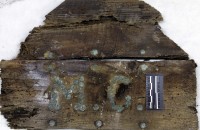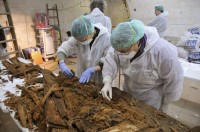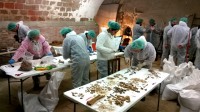 The team of archaeologists and anthropologists searching for the remains of Miguel de Cervantes in the crypt of Madrid’s Convent of the Barefoot Trinitarians have found fragments of a casket with the initials “M.C.” on one of the pieces. The partial casket was found in one of the niches in the north wall along with rocks and some bone fragments. The initials are formed with half-inch tacks pressed into the wood. The tacks are made of an unknown metal and are corroded to a green color.
The team of archaeologists and anthropologists searching for the remains of Miguel de Cervantes in the crypt of Madrid’s Convent of the Barefoot Trinitarians have found fragments of a casket with the initials “M.C.” on one of the pieces. The partial casket was found in one of the niches in the north wall along with rocks and some bone fragments. The initials are formed with half-inch tacks pressed into the wood. The tacks are made of an unknown metal and are corroded to a green color.
When researchers first examined the niche with an endoscope microcamera, they saw bone material, but they appeared to be a mix of at least 10 different individuals, including the remains of at least one infant. The mixture of skeletal remains and their position at the foot of the enclosure suggested this was not a primary burial but the result of a reinterral. After the forensic team removed the bones, they recovered the fragments of the coffin.
 The discovery was made on Saturday around noon. Earlier that morning the press had been allowed into the crypt to take pictures and observe the CSI-style team at work (hence this story). There was some excitement at the time when a group of researchers gathered around one of the gravesites found 4.8 meters under the floor which was outlined by a perimeter of bricks. Those remains turned out to be those of a young child under seven years of age at time of death.
The discovery was made on Saturday around noon. Earlier that morning the press had been allowed into the crypt to take pictures and observe the CSI-style team at work (hence this story). There was some excitement at the time when a group of researchers gathered around one of the gravesites found 4.8 meters under the floor which was outlined by a perimeter of bricks. Those remains turned out to be those of a young child under seven years of age at time of death.
It was Sunday when the team realized upon close examination of the coffin pieces that while moisture and insects had caused the coffin to fall to pieces, a significant piece from the head of the wooden casket had survived. Because sometimes in life luck happens, that piece had the initials tacked into it.
As suggestive as this find is, it doesn’t allow anything like a conclusion right now. There could have been another individual with the initials M.C. buried in the convent crypt. It could have been Cervantes’ coffin but his bones may have been lost in transit. It could be his coffin and his bones but we’ll never know because the remains are insufficient to determine identity.
 The forensic anthropologists are now separating out all the bones exhumed from the niche. First the bones of children, which are easily distinguished from those of adults, will be isolated from the pile. Then the team will arrange the rest by sex and examine any adult male remains for indications that they once formed the endoskeletal structure of the great writer of the Spanish Golden Age: atrophy in the metacarpals of the left hand and bullet wounds in the chest from shots Cervantes took at the Battle of Lepanto, advanced tooth loss, kyphosis (aka, a hunchback) brought on by severe arthritis.
The forensic anthropologists are now separating out all the bones exhumed from the niche. First the bones of children, which are easily distinguished from those of adults, will be isolated from the pile. Then the team will arrange the rest by sex and examine any adult male remains for indications that they once formed the endoskeletal structure of the great writer of the Spanish Golden Age: atrophy in the metacarpals of the left hand and bullet wounds in the chest from shots Cervantes took at the Battle of Lepanto, advanced tooth loss, kyphosis (aka, a hunchback) brought on by severe arthritis.
In addition to osteological evidence, researchers are also looking at the coffin itself to see if its consistent with the coffin that would have held Cervantes. The wood can be radiocarbon dated, or maybe even tree-ring dated if their luck holds, and textile fragments amidst the decaying organic material may be identifiable as part of the Franciscan religious habit in which Cervantes, who joined the Third Order of St. Francis shortly before his death, was buried.